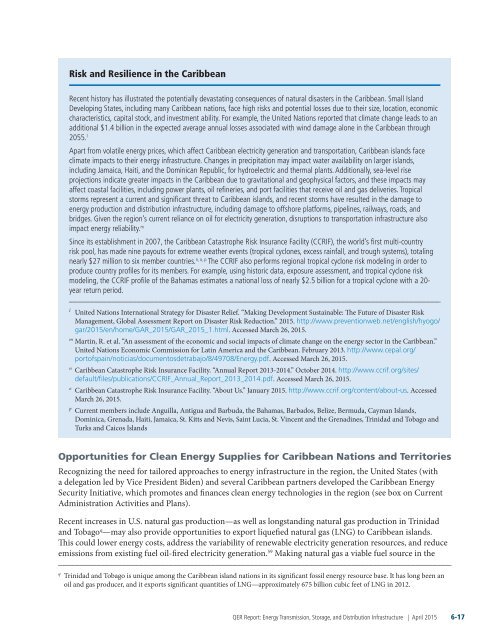LVXXU
LVXXU
LVXXU
Create successful ePaper yourself
Turn your PDF publications into a flip-book with our unique Google optimized e-Paper software.
Risk and Resilience in the Caribbean<br />
Recent history has illustrated the potentially devastating consequences of natural disasters in the Caribbean. Small Island<br />
Developing States, including many Caribbean nations, face high risks and potential losses due to their size, location, economic<br />
characteristics, capital stock, and investment ability. For example, the United Nations reported that climate change leads to an<br />
additional $1.4 billion in the expected average annual losses associated with wind damage alone in the Caribbean through<br />
2055. l<br />
Apart from volatile energy prices, which affect Caribbean electricity generation and transportation, Caribbean islands face<br />
climate impacts to their energy infrastructure. Changes in precipitation may impact water availability on larger islands,<br />
including Jamaica, Haiti, and the Dominican Republic, for hydroelectric and thermal plants. Additionally, sea-level rise<br />
projections indicate greater impacts in the Caribbean due to gravitational and geophysical factors, and these impacts may<br />
affect coastal facilities, including power plants, oil refineries, and port facilities that receive oil and gas deliveries. Tropical<br />
storms represent a current and significant threat to Caribbean islands, and recent storms have resulted in the damage to<br />
energy production and distribution infrastructure, including damage to offshore platforms, pipelines, railways, roads, and<br />
bridges. Given the region’s current reliance on oil for electricity generation, disruptions to transportation infrastructure also<br />
impact energy reliability. m<br />
Since its establishment in 2007, the Caribbean Catastrophe Risk Insurance Facility (CCRIF), the world’s first multi-country<br />
risk pool, has made nine payouts for extreme weather events (tropical cyclones, excess rainfall, and trough systems), totaling<br />
nearly $27 million to six member countries. n, o, p The CCRIF also performs regional tropical cyclone risk modeling in order to<br />
produce country profiles for its members. For example, using historic data, exposure assessment, and tropical cyclone risk<br />
modeling, the CCRIF profile of the Bahamas estimates a national loss of nearly $2.5 billion for a tropical cyclone with a 20-<br />
year return period.<br />
l<br />
United Nations International Strategy for Disaster Relief. “Making Development Sustainable: The Future of Disaster Risk<br />
Management, Global Assessment Report on Disaster Risk Reduction.” 2015. http://www.preventionweb.net/english/hyogo/<br />
gar/2015/en/home/GAR_2015/GAR_2015_1.html. Accessed March 26, 2015.<br />
m<br />
Martin, R. et al. “An assessment of the economic and social impacts of climate change on the energy sector in the Caribbean.”<br />
United Nations Economic Commission for Latin America and the Caribbean. February 2013. http://www.cepal.org/<br />
portofspain/noticias/documentosdetrabajo/8/49708/Energy.pdf. Accessed March 26, 2015.<br />
n<br />
Caribbean Catastrophe Risk Insurance Facility. “Annual Report 2013-2014.” October 2014. http://www.ccrif.org/sites/<br />
default/files/publications/CCRIF_Annual_Report_2013_2014.pdf. Accessed March 26, 2015.<br />
o<br />
Caribbean Catastrophe Risk Insurance Facility. “About Us.” January 2015. http://www.ccrif.org/content/about-us. Accessed<br />
March 26, 2015.<br />
p<br />
Current members include Anguilla, Antigua and Barbuda, the Bahamas, Barbados, Belize, Bermuda, Cayman Islands,<br />
Dominica, Grenada, Haiti, Jamaica, St. Kitts and Nevis, Saint Lucia, St. Vincent and the Grenadines, Trinidad and Tobago and<br />
Turks and Caicos Islands<br />
Opportunities for Clean Energy Supplies for Caribbean Nations and Territories<br />
Recognizing the need for tailored approaches to energy infrastructure in the region, the United States (with<br />
a delegation led by Vice President Biden) and several Caribbean partners developed the Caribbean Energy<br />
Security Initiative, which promotes and finances clean energy technologies in the region (see box on Current<br />
Administration Activities and Plans).<br />
Recent increases in U.S. natural gas production—as well as longstanding natural gas production in Trinidad<br />
and Tobago q —may also provide opportunities to export liquefied natural gas (LNG) to Caribbean islands.<br />
This could lower energy costs, address the variability of renewable electricity generation resources, and reduce<br />
emissions from existing fuel oil-fired electricity generation. 59 Making natural gas a viable fuel source in the<br />
q<br />
Trinidad and Tobago is unique among the Caribbean island nations in its significant fossil energy resource base. It has long been an<br />
oil and gas producer, and it exports significant quantities of LNG—approximately 675 billion cubic feet of LNG in 2012.<br />
QER Report: Energy Transmission, Storage, and Distribution Infrastructure | April 2015 6-17


